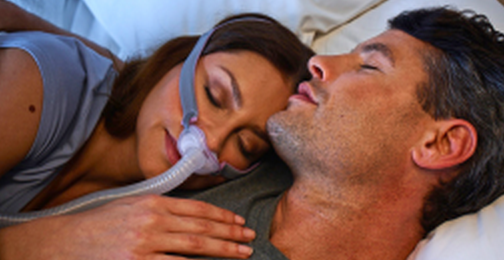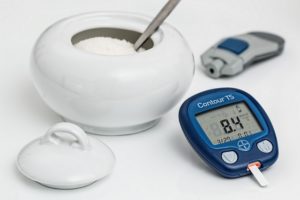Sleep Apnea

Sleep apnea is a common condition where the upper airway collapses during sleep causing episodes of reduced breathing. Risk factors include Increasing age, being overweight, and structural abnormalities of the upper mouth and throat. Somewhere between 15-30% of men and 10-15% of women have sleep apnea which often goes undiagnosed (Young 2009, Chen 2021).
The condition can range from mild to severe, with some individuals waking repeatedly from episodes of stopped breathing. Over time, the disruption in sleep and oxygenation can have damaging effects on the body. Common symptoms include choking or gasping at night, morning headache and daytime fatigue (Myers 2013). Snoring is also common in people with sleep apnea, although snoring can be present without the disease.
Conditions and Concerns Associated with Sleep Apnea
Sleep apnea is associated with a number of concerns, including:
- Mental health problems
- Heart disease
- Diabetes
- Increased car accidents
Mental Health and Sleep Apnea
Individuals with sleep apnea often struggle with mental health conditions. Some of the latest data appears to indicate large correlations between sleep apnea, depression and anxiety. Depression risks were 3.11 times higher and anxiety was 3.68 times higher in individuals with sleep apnea (Kaufmann 2017).
Of additional concern, sleep apnea can cause cognitive dysfunction as well. Individuals with sleep apnea often develop memory issues, difficulty focusing, irritability and problems with executive brain function (Tingting 2021). Long-term, sleep apnea increases risks for cognitive decline and dementia (Chauhan 2021). When treated, these risks decrease.
Heart Disease
It has been recognized for a while that people struggling with sleep apnea have higher risks for heart disease. In fact, sleep apnea directly raises risks for high blood pressure, stroke, angina (chest pain due to heart disease), heart failure and heart rhythm problems (Rivas-Echeverria 2021). In some heart disease conditions, 60% of patients have sleep apnea—a stunning percentage. Fortunately, it has also been shown that treating sleep apnea reduces heart disease risks.
Diabetes
Like heart disease, it’s also been well known that sleep apnea raises risks for blood sugar problems and diabetes (Botros 2009). And like heart disease risks, the risks for diabetes also decrease when sleep apnea is effectively treated.
Car Accidents
Considering the problems of cognitive dysfunction and daytime drowsiness seen in patients with sleep apnea, it should come as no surprise that these individuals are at higher risk for car accidents. Some of the published research shows somewhat alarming statistics. Risks for car accidents are increased by 2.3 times in sleep apnea patients. Even more concerning, risks for multiple car accidents in sleep apnea patients is increased by 5.2 times (Barbe 1998). Patients with sleep apnea often have repeated automobile accidents.
Integrative Treatment Approaches
Standard approaches for sleep apnea include continuous positive airway pressure (CPAP), custom made oral appliances and surgery. In overweight patients, losing weight can help as well. Unfortunately, some patients don’t tolerate CPAP therapy and additional treatment options are needed.
Additional treatments that appear to hold promise include:
- Exercise and improved fitness
- Specific airway exercises
- Singing and wind instruments
- Antioxidant therapy
Exercise for Sleep Apnea
Exercise has multiple benefits for improving health. Interestingly, for sleep apnea, exercise benefits seem to extend beyond simple weight loss. A recent meta-analysis of exercise therapy for sleep apnea showed an almost 50% reduction in risk for sleep apnea in patients that engaged in exercise (Aiello 2016). Aerobic-type exercise was the most often studied.
Airway Exercises
Specific exercises for strengthening the muscles throughout the upper airway also appear to have beneficial effects. In patients with moderate, but not severe sleep apnea, upper airway exercises decreased the severity of sleep apnea from moderate to mild (Mohamed 2017). Overall, the evidence needs to include larger, blinded trials, but the current data indicates improvements in sleep quality and daytime drowsiness with airway exercises (Rueda 2020). The Sleep Foundation has a description of the exercises found to be helpful.
Singing and Wind Instruments (Didgeridoo)

Evidence has also been accruing that singing and playing certain wind instruments can have a small but meaningful impact on reducing sleep apnea (Weijden 2020). The Australian aboriginal instrument, the didgeridoo, has some of the strongest evidence suggestive of modest benefits. Singing also appears to hold some promise. If you have sleep apnea and have been looking for a hobby, practicing a wind instrument or singing may be worth pursuing.
Antioxidant Therapy
In patients with sleep apnea, levels of free radicals, molecules that can cause damage and inflammation, appear higher and may contribute to the disease. Early studies attempting to address the presence of excess free radicals with antioxidants appear to hold some promise. N-acetylcysteine is an amino acid precursor to glutathione, one of the body’s major antioxidant defenses. A single study assessed 30 days of n-acetylcysteine for sleep apnea and found improvements in several parameters of the disease (Sadasivam 2011).
Vitamin C is another well-known antioxidant. A separate clinical trial used a single intravenous dose of vitamin C and found improved air flow in sleep apnea. Patients with sleep apnea treated with vitamin C had flow parameters improve to levels seen in control subjects without the condition (Grebe 2006). The authors conclude that antioxidants may be a valid treatment approach. It’s possible oral vitamin C may provide similar benefits, however, it hasn’t been studied directly.
Conclusion
Sleep apnea is a common condition with serious long-term consequences. In my experience, a good percentage of people do not tolerate CPAP machines. Other treatment options, including different forms of exercise and antioxidant therapies may be worth considering in select patients.



